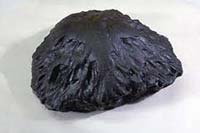Thursday, 25 August 2022
 A Very British Meteorite
A Very British Meteorite
Speaker: Martin Lunn
The guest speaker at Todmorden u3a's monthly meeting on the 18th of August was Martin Lunn, MBE, FRAS, whose talk was entitled 'A Very British Meteorite'.
Martin stepped in at very short notice when the advertised speaker was unable to attend the meeting.
The 'Very British Meteorite' is also known as the Middlesborough Meteorite, as it landed in that area.
 Meteorites normally enter our atmosphere at a speed of twenty to fifty miles per second and punch a cortex of air in front of them. This usually makes them tumble as they fall to the ground, due to changes in air pressure and temperature. But the Middlesborough meteorite rotated on its axis, which meant that only one side of it was burnt, and was described as a 'textbook example of an orientated meteorite', making it one of the most important meteorites ever to hit Earth. It is almost half sphere-shaped and landed at 3.35pm on the 14th of March 1881. We know this because it was seen to land by railwaymen working nearby.
Meteorites normally enter our atmosphere at a speed of twenty to fifty miles per second and punch a cortex of air in front of them. This usually makes them tumble as they fall to the ground, due to changes in air pressure and temperature. But the Middlesborough meteorite rotated on its axis, which meant that only one side of it was burnt, and was described as a 'textbook example of an orientated meteorite', making it one of the most important meteorites ever to hit Earth. It is almost half sphere-shaped and landed at 3.35pm on the 14th of March 1881. We know this because it was seen to land by railwaymen working nearby.
Leaving the main subject, Martin told us about the asteroid belt, situated between the planets Mars and Jupiter. Most of the asteroids in the belt are unlikely to strike Earth, but astronomers have identified some objects that are drifting away from the belt, and may, at some time, enter the Earth's yearly orbit around the sun. This has happened before, and could be repeated. Such a rock hit the earth around fifty thousand years ago, and was thought to be 50 metres across, causing a hole measuring three quarters of a mile wide, called the Barringer Crater, situated in Arizona. Our nearest neighbour in space, the Moon, sustained over 200 impacts from objects over 20 metres across in one particular area, from 2009 to 2014. Meteorite strikes have occurred regularly on Earth over the centuries.
 Martin returned to the main theme of his presentation – The Middlesborough Meteorite. This came to Earth at Pennymans's Siding, part of the North Eastern Railway Line which at that time was in Yorkshire, and was witnessed by four railwaymen. They described hearing a 'whooshing' followed by an impact nearby. They saw a hole which was emitting smoke, and drawing near, the foreman, a Mr Ellinor, invited one of his crew to put his hand in the hole to see what was there. The actual reply is probably lost in history, but after finding how hot whatever was in the hole was, the Middlesborough Meteorite was pulled out.
Martin returned to the main theme of his presentation – The Middlesborough Meteorite. This came to Earth at Pennymans's Siding, part of the North Eastern Railway Line which at that time was in Yorkshire, and was witnessed by four railwaymen. They described hearing a 'whooshing' followed by an impact nearby. They saw a hole which was emitting smoke, and drawing near, the foreman, a Mr Ellinor, invited one of his crew to put his hand in the hole to see what was there. The actual reply is probably lost in history, but after finding how hot whatever was in the hole was, the Middlesborough Meteorite was pulled out.
Subsequently there were reports of loud bangs being heard from the sky not far away in Northallerton, which was probably the meteorite entering the atmosphere, or breaking the sound barrier. Back at the hole, the men wondered what the object was, and what should they do about it? The General Manager was due to make his rounds the following day, so the decision was to leave the object on a nearby pile of ballast overnight and let him decide. Subsequently, the object was taken to Darlington first for tests.
More scientists became interested, and there was a suggestion that the object should be moved to London. The Railway Company said it should be displayed in Yorkshire. The argument was won when the owners of the railway pointed out that it was discovered on their property. It was placed in railway's found property office for six months, before the decision was made that it would be given to the Yorkshire Museum, where it still can be seen today.
The presentation was enjoyed by the members present, and Martin answered questions, before a richly deserved vote of thanks, and applause which ended the meeting.
The next Todmorden U3A Monthly Members Meeting will be on Thursday 15 September 2022 at 1.45 pm open to all fully paid-up members at the Central Methodist Hall, Todmorden, when Noel Moroney will give a talk entitled: 'Yarns for the Textile Trade – or Close Encounters of a Famous Kind'
Not yet a member? You can attend one talk free by requesting an invitation to this zoom event. We're always delighted to welcome new members. Contact details: website at www.u3atod.org.uk or email at info@u3atod.org.uk.
Many thanks to Colin Sanson for this report
Previous U3A reports on the HebWeb - click here

